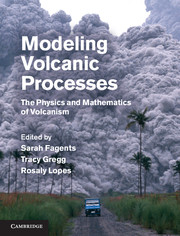Book contents
- Frontmatter
- Contents
- Contributors
- Chapter 1 Introduction
- Chapter 2 Magma chamber dynamics and thermodynamics
- Chapter 3 The dynamics of dike propagation
- Chapter 4 Dynamics of magma ascent in the volcanic conduit
- Chapter 5 Lava flows
- Chapter 6 Unsteady explosive activity
- Chapter 7 Unsteady explosive activity
- Chapter 8 Sustained explosive activity
- Chapter 9 Modeling tephra sedimentation from volcanic plumes
- Chapter 10 Pyroclastic density currents
- Chapter 11 Magma–water interactions
- Chapter 12 Deep-sea eruptions
- Chapter 13 Volcano–ice interactions
- Chapter 14 Modeling lahar behavior and hazards
- Chapter 15 Introduction to quantitative volcano seismology
- Chapter 16 Volcano acoustics
- Chapter 17 Planetary volcanism
- Index
- Plate section
- References
Chapter 17 - Planetary volcanism
Published online by Cambridge University Press: 05 March 2013
- Frontmatter
- Contents
- Contributors
- Chapter 1 Introduction
- Chapter 2 Magma chamber dynamics and thermodynamics
- Chapter 3 The dynamics of dike propagation
- Chapter 4 Dynamics of magma ascent in the volcanic conduit
- Chapter 5 Lava flows
- Chapter 6 Unsteady explosive activity
- Chapter 7 Unsteady explosive activity
- Chapter 8 Sustained explosive activity
- Chapter 9 Modeling tephra sedimentation from volcanic plumes
- Chapter 10 Pyroclastic density currents
- Chapter 11 Magma–water interactions
- Chapter 12 Deep-sea eruptions
- Chapter 13 Volcano–ice interactions
- Chapter 14 Modeling lahar behavior and hazards
- Chapter 15 Introduction to quantitative volcano seismology
- Chapter 16 Volcano acoustics
- Chapter 17 Planetary volcanism
- Index
- Plate section
- References
Summary
Overview
Volcanism is of primary importance in shaping the surfaces of many planets and satellites of the Solar System. In this chapter we show how models developed for volcanic processes on Earth can be adapted to model volcanism on other planetary bodies, including those displaying familiar silicate volcanism (such as Mars, Venus, and the Moon), as well as those with more exotic volcanic behavior (such as high-temperature volcanism on Io and “cryovolcanism” on the icy satellites). Due to space limitations, only certain “type example” worlds are detailed here, the intent is more to give an insight into how the volcanic process varies from body to body than to discuss each. Each planet or satellite possesses a unique combination of environmental factors (gravity, atmospheric properties, surface temperature, etc.) that influence almost every aspect of magma ascent and eruption. By incorporating these parameters into models of volcanic behavior it is possible to elucidate the causes of the diversity in volcanic expression on the surfaces of other planetary bodies and hence understand the eruptive history and evolution of our Solar System neighbors.
Introduction
Volcanism has affected all solid planets and most moons in the Solar System and even some of the earliest-forming asteroids, and is therefore of key importance for the study of the evolution of planets and moons. The discovery of numerous extra-terrestrial volcanoes, including active ones, has stretched our traditional definition of “volcano” (Lopes et al., 2010a) and prompted a new understanding of how volcanism, as a process, can operate.
- Type
- Chapter
- Information
- Modeling Volcanic ProcessesThe Physics and Mathematics of Volcanism, pp. 384 - 413Publisher: Cambridge University PressPrint publication year: 2013
References
- 5
- Cited by



